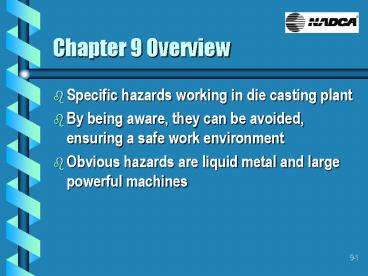Chapter 9 Overview - PowerPoint PPT Presentation
Title:
Chapter 9 Overview
Description:
Chapter 9 Overview Specific hazards working in die casting plant By being aware, they can be avoided, ensuring a safe work environment Obvious hazards are liquid ... – PowerPoint PPT presentation
Number of Views:86
Avg rating:3.0/5.0
Title: Chapter 9 Overview
1
Chapter 9 Overview
- Specific hazards working in die casting plant
- By being aware, they can be avoided, ensuring a
safe work environment - Obvious hazards are liquid metal and large
powerful machines
2
Chapter 9 Objectives
- Correctly identify personal protective equipment
- List eight hazards in the die casting workplace
- List seven steps to safely use compressed air
- List six steps to safe handling of castings
3
Safety in the Workplace
- Safety is a defensive attitude
- Pursuit of safety requires top management to be
fully committed to safety - Hazards occurring in the die casting plant
- Pinch, snag, strike, burn, electric shock,
pierce, slip-fall, trip-fall and fire
4
Protective Clothing
- Wear natural vs. synthetic clothing
- Cover up
- Shirts with long sleeves, buttoned at the wrist
- Long pants
- Molders boots
- Gloves
- Safety glasses
- Helmut, if required
5
Machine Safety
- DCM has
- Moving parts, pinch and shear points, lubricants,
hydraulic fluid, and electrical controls - Particular areas of the machine may be hot
- Die casting die
- Hot at operating temperatures, can have pinch and
shear points - Auxiliary equipment has specific safety
considerations
6
Work EnvironmentTrip-fall Hazards
- Must keep area neat and clean
- Tripping obstacles can cause injury
- Machines have components that project out
- These are trip-fall hazards
- These items should be painted with standard OSHA
color coding to make them more visible
7
Work EnvironmentNoise
- Excessive noise can be a hazard that can result
in hearing loss - The combination of noises make it wise to use
hearing protection - At minimum, earplugs are recommended
8
Work EnvironmentSlip-fall Hazards
- Lubricants, release, cooling agents often get on
the floor and cause a slip-fall hazard - Follow good house-keeping practices
- Use surface-drying compounds on spills
- Follow rigid equipmentmaintenance and
preventative programs
9
Work EnvironmentFloor Clutter
- Floor clutter creates slip-fall hazards
- Electric cords, cables, and hoses running
across the floor - Process debris such as scrap, biscuits, runners,
overflows, sprues - All hoses, pipes and cables at floor level should
be in a trench that is properly covered
10
Work EnvironmentOperator Platforms and Controls
- Operator Platforms
- These establish the proper working height and
prevent fatigue - Should be of uniform height for similar machines
- Need to provide a non-skid surface
- Proper working heights minimize physical strain
- Controls
- Must be at the proper height to avoid fatigue
11
High Pressure Air
- Escaping air can be noisy and an air blast can
carry small particles of dirt or metal - Air connections should be secured by strong
couplings and connectors - Air hoses should be arranged to prevent tripping
hazards
12
Steps of High Pressure Air Safety
- Check all air hose connections before turning on
the air or pressurizing the lines - When turning air on or off, hold nozzle end of
the hose to prevent whipping of the air line - Shut off the air before adjusting air tools
- Never point an air nozzle at anyone
13
Steps of High Pressure Air Safety cont.
- Do not use air to dust off hair or clothing, or
to sweep the floor - Wear safety glasses when using high-pressure air
- Inspect air hoses regularly and request prompt
repair of defective lines
14
Material Handling
- Inspect materials
- Get a firm grip on the object
- Keep fingers away from pinch points
- Keep hands away from the ends of long objects to
prevent pinching hands - Wipe off greasy, wet, slippery or dirty objects
before trying to handle them - Keep hands free of oil and grease
15
Working with MetalsExplosion
- If any liquid containing water gets under the
surface of the liquid metal, the water will
turn to steam, causing the metal to explode and
spray out of the furnace - When water turns to steam, it rapidly expands to
1500 times its volume - Can be a secondary explosion, more violent than
the first
16
Industry Safety
- Incidence rate for lost work injuries
- In aluminum die casting at 7.8 per 100 workers
- 6.4 per 100 workers in other non-ferrous die
casting - These rates are almost double those for all
manufacturing sectors at 4.2 incidents per 100
workers
17
Summary
- Many hazards are associated with working in a die
casting plant - Safety is a defensive attitude, requiring
commitment from top management down - Personal protective clothing and accessories
helps minimize your risk to certain hazards - Several places on the DCM can cause injury,
including hot dies, pinch and shear points
18
Summary
- Work environment hazards include cords, hoses,
floor clutter, and obstacles - High pressure air can be hazardous follow safety
guidelines when using it - Always follow the safety guidelines when handling
materials - Liquid metals can explode if any water is mixed
into the melted metal































